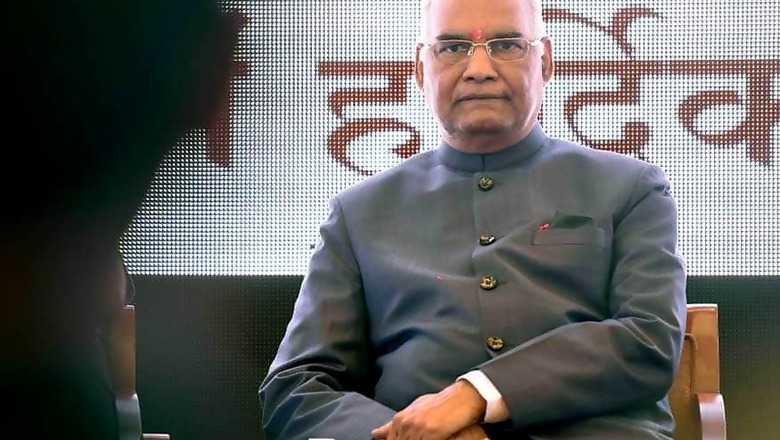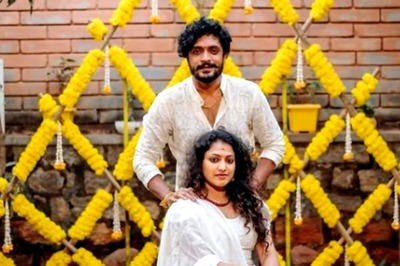
views
New Delhi: As President Ram Nath Kovind settles down in the grand sandstone complex that is now his home, conservationists hope that the present occupant of Rashtrapati Bhavan, like his predecessors, will usher in change that renews the old.
From restoration of the Bhavan's main building to allowing greater accessibility through open house sessions, heritage experts have a wish list drawn up for Kovind.
The nearly 90-year-old Raj-era landmark in the heart of New Delhi was given a makeover in select areas by earlier presidents, they pointed out.
While Pranab Mukherjee focused on enhancing its architectural grandeur during his term, A P J Abdul Kalam added a herb garden in the complex to add to the horticultural splendour of the President's Estate spread over 330 acres.
Conservationist Swapna Liddle expressed the hope that the new president would consider restoring the main building, proposed by the Indian National Trust for Art and Cultural Heritage (INTACH).
"INTACH has worked on the restoration of the President's Estate through various projects, some completed, some still underway. And now we have proposed the restoration of the main building of the Bhavan," Liddle, INTACH's Delhi Chapter convener, said.
At the last function of outgoing president Mukherjee at the Bhavan, a voluminous 'Conservation Management Plan' prepared by the INTACH was presented to him, she said.
"He in turn handed it over to the then President-elect," Liddle told PTI.
Mukherjee, 81, has bequeathed to Kovind, 71, a legacy of cultural and architectural preservation, which a heritage expert said was one of Mukherjee's abiding passions.
"His vision of heritage was very holistic. He was very interested in and enthusiastic about every restoration project that was taking place or being planned," architect and urban planner AGK Menon said.
Delhi-based heritage activist Vikramjit Singh Rooprai said both Mukherjee and Kalam also made the country's first residence more accessible to the people.
"With the Bhavan getting a new occupant, we also hope Kovind sahab would further widen the ambit of accessibility and let the common man get closer to the grand building and its historic treasures, especially through open house sessions," Rooprai said.
The centrepiece of the Raisina Hill capital complex, designed by British architect Sir Edwin Landseer Lutyens as the Viceroy's House, became the residence of the Head of State of the Republic of India in 1950.
The outer structure of the Bhavan is composed of red and beige sandstones, while the inside was constructed with brick, lime mortar and other material.
Parts of the complex, spread over 330 acres of land and endowed with 340 rooms, gardens and crafted fountains, were given a makeover during Mukherjee's five-year tenure.
Decrepit stables were converted into a museum, colonial-era clock towers refurbished and a building of the President's
Bodyguard (PBG) was restored.
INTACH collaborated on many restoration projects, including a 1925-built clock tower inaugurated in July, 2015. The tower, built by Lutyens, now houses the reception zone of a museum complex, cafeteria and souvenir shop.
The museum, spread over 10,000 sqm, is a hi-tech story-telling centre, revolving around tales of British Viceroys who occupied the Bhavan till 1947, the transfer of power and the life and work of presidents since 1950, among other themes.
The 13th president also opened a restored building of the PBG earlier this month.An elite household cavalry regiment of the Indian Army, the PBG has been active since 1773.
After restoration, the 1920-era PBG building gleams in its all-white glory as the clock tower atop it chimes in time. Work on the construction of the complex as the seat of the British imperial power began in 1912, a year after the capital of the Raj was shifted from Calcutta to Delhi.
Lutyens, while designing the Viceroy's House, created a new order for the columns used in the building -- the Delhi Order. The pillars were embellished with bells and motifs of elephants, a running theme across the architectural landscape.
Completed in 1929, it is one of the most visited and photographed buildings in Delhi. It encompasses 1 1/2 miles of corridors, 227 columns and 37 fountains, including roof fountains.
The Viceroy's House, alongside the identical North Block and South Block buildings, was inaugurated as part of the new imperial capital of New Delhi in February 1931.
After India became a Republic, it was rechristened Rashtrapati Bhavan.
In the forecourt of the building is a monumental column--the Jaipur Column. Made of sandstone, it carries a five-tonne bronze lotus from which emerges a six-pointed 'Star of India', made of glass. The star was installed in 1930.
The Jaipur Column has carvings that face the north and south. On the eastern side is a map of Delhi, as envisioned then, and an inscription that runs through three sides of the column.
It reads, "In thought faith, In word wisdom; In deed courage; In life service; So may India be great."


















Comments
0 comment